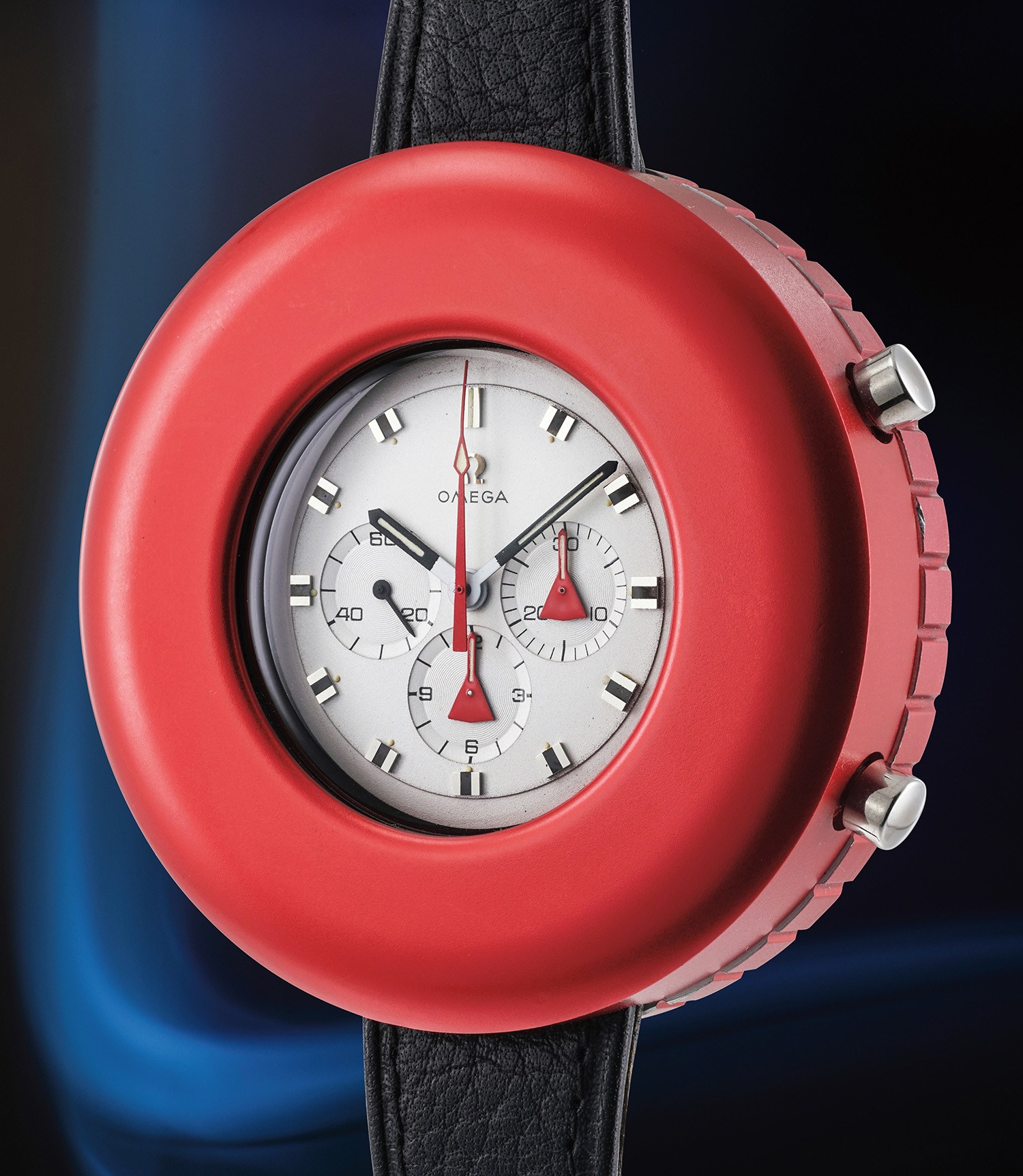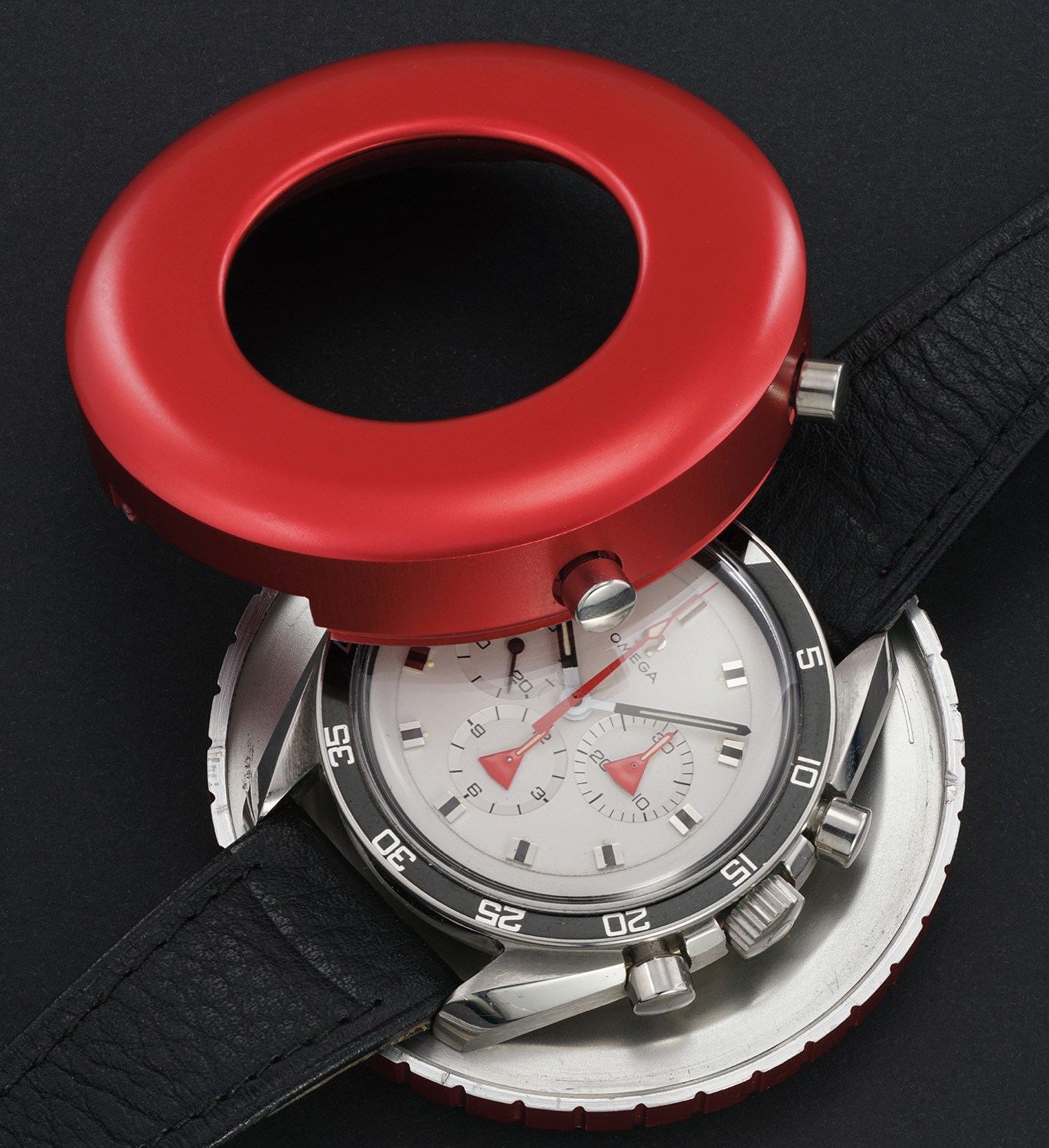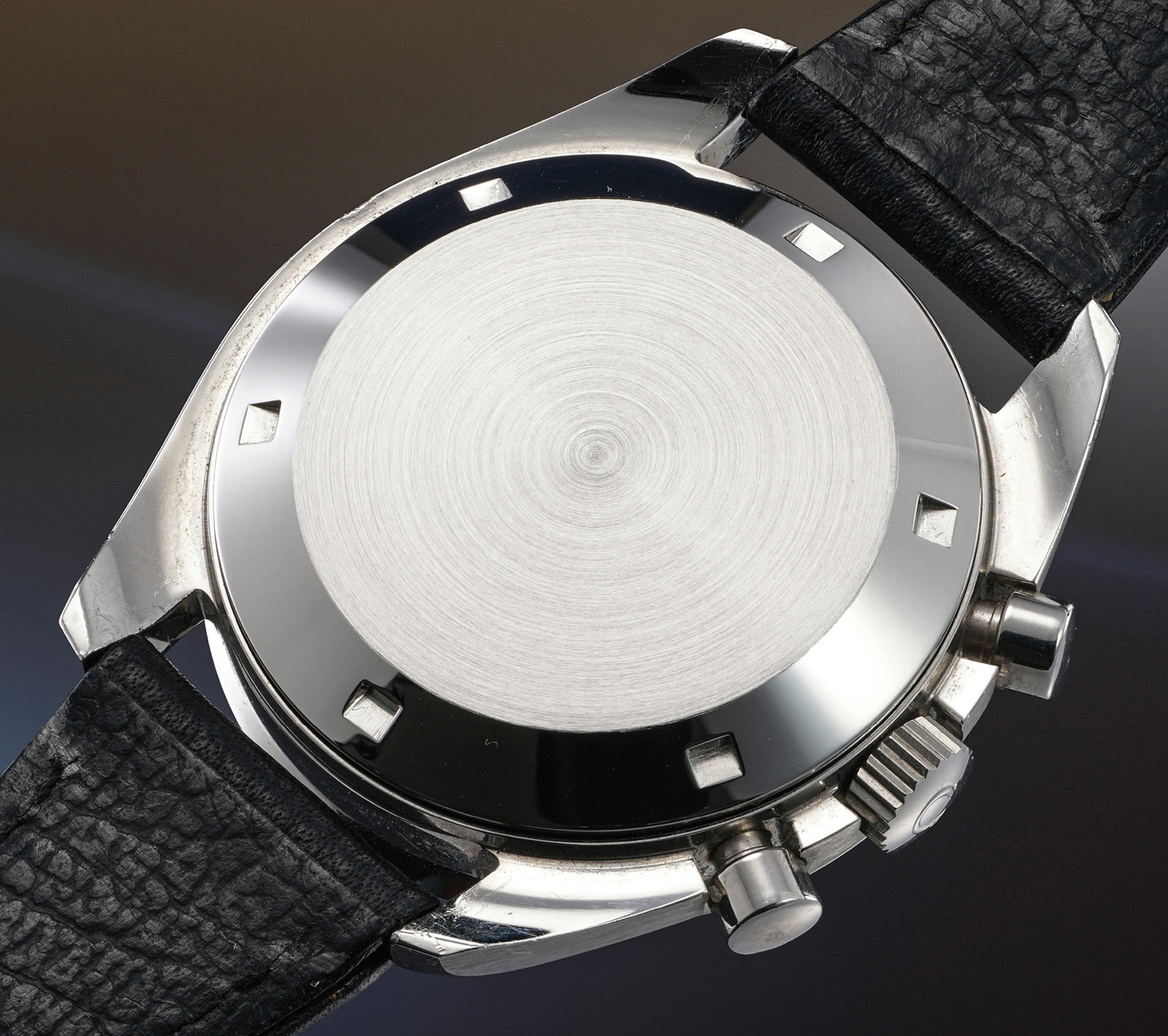









74
Omega
Ref. 145.022
Speedmaster Professional "Alaska Project"
An extremely rare and unusual stainless steel prototype chronograph wristwatch with white dial and 60 minutes bezel, accompanied by red thermo-protective case, made for NASA
- Estimate
- CHF100,000 - 200,000$100,000 - 200,000€103,000 - 206,000
CHF201,600
Lot Details
- Manufacturer
- Omega
- Year
- Circa 1970
- Reference No
- 145.022
- Movement No
- 001'629
- Model Name
- Speedmaster Professional "Alaska Project"
- Material
- Stainless steel
- Calibre
- Manual, cal. 861, 18 jewels
- Bracelet/Strap
- Leather
- Clasp/Buckle
- Omega Stainless Steel pin buckle
- Dimensions
- 40mm Diameter
- Signed
- Case, dial, movement and buckle signed
Specialist
Full-Cataloguing
Catalogue Essay
We are thrilled to offer with the present lot a watch that is widely considered throughout the collector community as a “holy grail” Omega Speedmaster, one of the most rare and fascinating creations of the brand.
It is by now common knowledge that Omega undertook a series of secret projects for Nasa. Codenamed “Alaska” (I to IV), the name had nothing to do with geography, rather was randomly selected according to Omega’s internal rule that demanded new watch projects would be code-named after a city or State (such as the somewhat ominously sounding “Manhattan Project” for the Constellation) while movement projects would be code-named after birds (such as “Albatross” for the Chrono-quartz)
The present piece is indeed part of this restricted and extremely specific output. According to information received from the Omega Museum, the present piece appears to be a intermediate effort to be placed between the Alaska I (1969) and Alaska II (1970) projects. In fact, while this cannot be 100% confirmed, the Museum thinks this watch might mark “the beginning of said “Alaska II” series of projects.”. It is unnecessary to point out the peculiarity of such a timepiece, even in the already highly uncommon panorama of the Alaska Project pieces.
The collaboration between Omega and Nasa dates back to before NASA’s most famous Apollo 11 moon landing mission. Since then, OMEGA would go on to produce a series of test-watches, all of which were proposed to NASA in a project that would span many years.
Following the cancellation of the Apollo missions after Apollo 17 (missions 18 through 22), there was no immediate use for the ALASKA Project’s test-watches, so the project was temporarily terminated, though remarkable progress had been made. This first phase of the development can be called “ALASKA I”.
Beginning in 1971, Omega began work on a continuation of its secret project, now internally titled “ALASKA II”, which involved several studies and prototypes. The present lot is as mentioned one of the earliest “ALASKA II” prototypes, and is closely related to the production Speedmaster Professional, featuring more similarities to it than Alaska I iterations. At the time, it paired most of the tested technologies of “ALASKA I” (the white dial and a new, red anodized aluminum outer protective case just to name a few) with the trusted and legendary Speedmaster “Moonwatch” case of the (then) current reference ST 145.022.
The “ALASKA II” test-watches were delivered to Houston in the beginning of 1972. While once again considerable progress had been made, since the Apollo Program had come to an end by the end of 1972, the “ALASKA II” test-watches were not retained by the program office and the series of OMEGA’s Alaska Projects came to a halt once more.
As it happens for some Alaska I and Alaska II pieces, the watch comes accompanied with an additional very large, red anodized aluminium case originally intended as a protective heat shield. While highly unlikely it will serve its original function during everyday usage, it adds incredible character to the piece and tremendously highlight its ethos of “space watch”.
Other distinguishing characteristic of the piece are, most notaby, its matte white dial with black racing hands and “Apollo” style register red hands. The dial was made white to better reflect light and radiation in general (polar opposite the the standard Speedmaster’s black dial which would absorb radiation with the consequent risk of overheating). Additionally, the dial was coated with zinc oxide, a material known for being highly resistant to solar radiation. These “ALASKA” project prototype watches were, notably, the first Speedmasters ever to be fitted with white dials.
As if these rare elements weren’t enough, it’s fitted with one of the most uncommon bezels to be found on an Alska timepiece, featuring simple 5-minutes markers. It is easy to understand how Nasa eventually demanded a tachometer scale on the bezel (as seen on virtually all other Alaska models), which makes this prototype even more uncommon.
Scholarship suggests this is one of only three examples of the “ALASKA II” project watch with the original red protective case – one residing permanently in the Omega Museum and the other in a prominent private collection. These prototype watches are therefore amongst the rarest of all Speedmasters. The present lot’s rarity, well-preserved condition, and vibrant aesthetic make it one of the most exciting examples of a Speedmaster to appear on the market. The ultimate in rarity and exclusivity, it is a trophy watch deserving of a prominent place in any collection of important and rare sports watches.
We sincerely thank the Omega Museum for their updated scholarship and historical perspective in providing their own invaluable research and information on the present lot.
It is by now common knowledge that Omega undertook a series of secret projects for Nasa. Codenamed “Alaska” (I to IV), the name had nothing to do with geography, rather was randomly selected according to Omega’s internal rule that demanded new watch projects would be code-named after a city or State (such as the somewhat ominously sounding “Manhattan Project” for the Constellation) while movement projects would be code-named after birds (such as “Albatross” for the Chrono-quartz)
The present piece is indeed part of this restricted and extremely specific output. According to information received from the Omega Museum, the present piece appears to be a intermediate effort to be placed between the Alaska I (1969) and Alaska II (1970) projects. In fact, while this cannot be 100% confirmed, the Museum thinks this watch might mark “the beginning of said “Alaska II” series of projects.”. It is unnecessary to point out the peculiarity of such a timepiece, even in the already highly uncommon panorama of the Alaska Project pieces.
The collaboration between Omega and Nasa dates back to before NASA’s most famous Apollo 11 moon landing mission. Since then, OMEGA would go on to produce a series of test-watches, all of which were proposed to NASA in a project that would span many years.
Following the cancellation of the Apollo missions after Apollo 17 (missions 18 through 22), there was no immediate use for the ALASKA Project’s test-watches, so the project was temporarily terminated, though remarkable progress had been made. This first phase of the development can be called “ALASKA I”.
Beginning in 1971, Omega began work on a continuation of its secret project, now internally titled “ALASKA II”, which involved several studies and prototypes. The present lot is as mentioned one of the earliest “ALASKA II” prototypes, and is closely related to the production Speedmaster Professional, featuring more similarities to it than Alaska I iterations. At the time, it paired most of the tested technologies of “ALASKA I” (the white dial and a new, red anodized aluminum outer protective case just to name a few) with the trusted and legendary Speedmaster “Moonwatch” case of the (then) current reference ST 145.022.
The “ALASKA II” test-watches were delivered to Houston in the beginning of 1972. While once again considerable progress had been made, since the Apollo Program had come to an end by the end of 1972, the “ALASKA II” test-watches were not retained by the program office and the series of OMEGA’s Alaska Projects came to a halt once more.
As it happens for some Alaska I and Alaska II pieces, the watch comes accompanied with an additional very large, red anodized aluminium case originally intended as a protective heat shield. While highly unlikely it will serve its original function during everyday usage, it adds incredible character to the piece and tremendously highlight its ethos of “space watch”.
Other distinguishing characteristic of the piece are, most notaby, its matte white dial with black racing hands and “Apollo” style register red hands. The dial was made white to better reflect light and radiation in general (polar opposite the the standard Speedmaster’s black dial which would absorb radiation with the consequent risk of overheating). Additionally, the dial was coated with zinc oxide, a material known for being highly resistant to solar radiation. These “ALASKA” project prototype watches were, notably, the first Speedmasters ever to be fitted with white dials.
As if these rare elements weren’t enough, it’s fitted with one of the most uncommon bezels to be found on an Alska timepiece, featuring simple 5-minutes markers. It is easy to understand how Nasa eventually demanded a tachometer scale on the bezel (as seen on virtually all other Alaska models), which makes this prototype even more uncommon.
Scholarship suggests this is one of only three examples of the “ALASKA II” project watch with the original red protective case – one residing permanently in the Omega Museum and the other in a prominent private collection. These prototype watches are therefore amongst the rarest of all Speedmasters. The present lot’s rarity, well-preserved condition, and vibrant aesthetic make it one of the most exciting examples of a Speedmaster to appear on the market. The ultimate in rarity and exclusivity, it is a trophy watch deserving of a prominent place in any collection of important and rare sports watches.
We sincerely thank the Omega Museum for their updated scholarship and historical perspective in providing their own invaluable research and information on the present lot.
Omega
Swiss | 1848Omega's rich history begins with its founder, Louis Brandt, who established the firm in 1848 in La Chaux de Fonds. In 1903, the company changed its name to Omega, becoming the only watch brand in history to have been named after one its own movements. A full-fledged manufacturer of highly accurate, affordable and reliable watches, its sterling reputation enabled them to be chosen as the first watch company to time the Olympic Games beginning in 1932. Its continued focus on precision and reliability ultimately led their Speedmaster chronograph wristwatch to be chosen by NASA in 1965 — the first watch worn on the moon.Key models sought-after by collectors include their first, oversized water-resistant chronograph — the reference 2077, early Speedmaster models such as the CK 2915 and 2998, military-issued versions of the Seamaster and oversized chronometer models such as those fitted with their prestigious caliber 30T2Rg.
Browse Maker